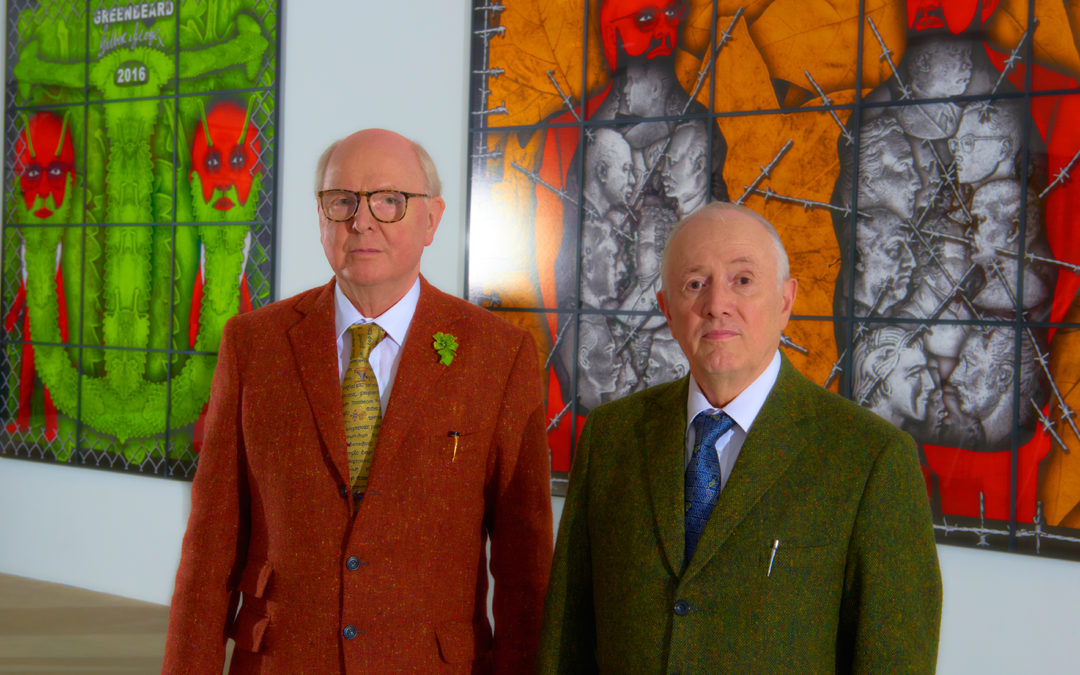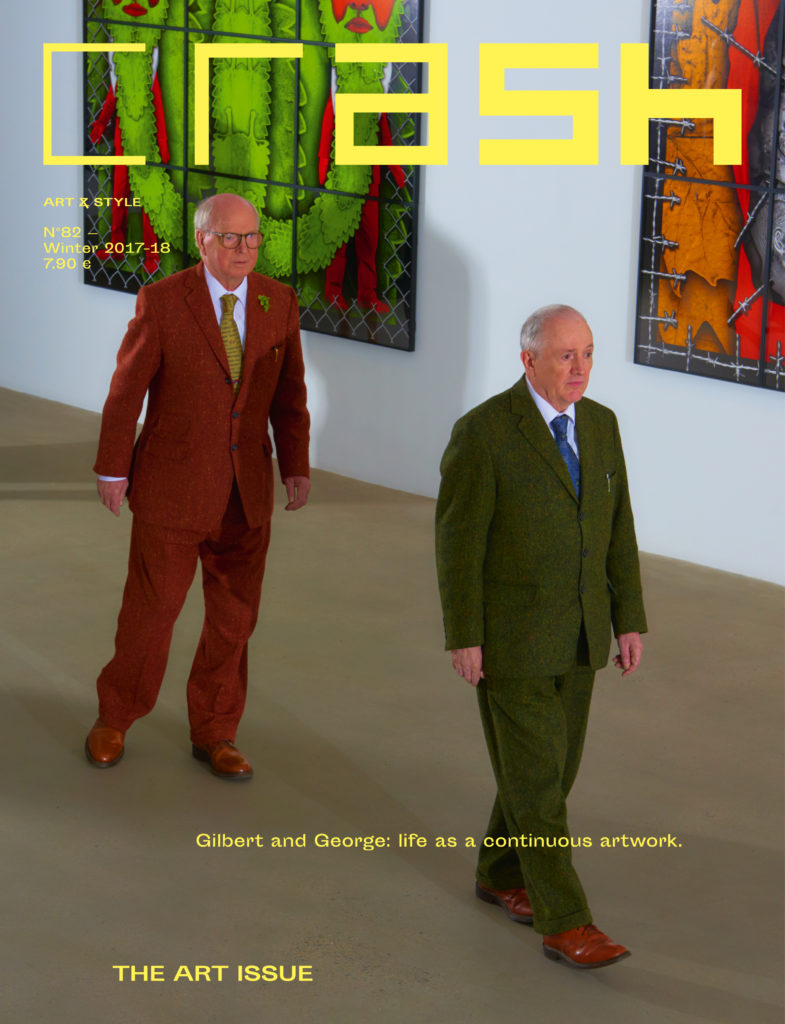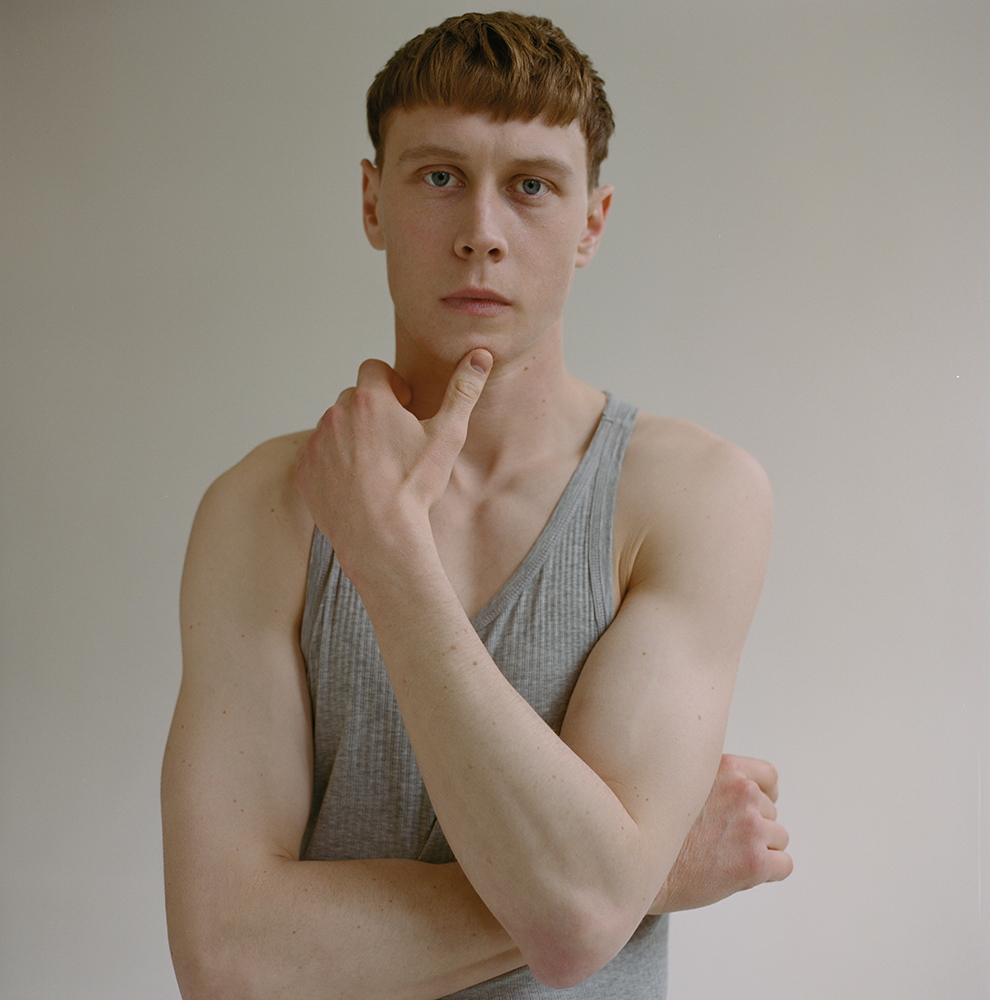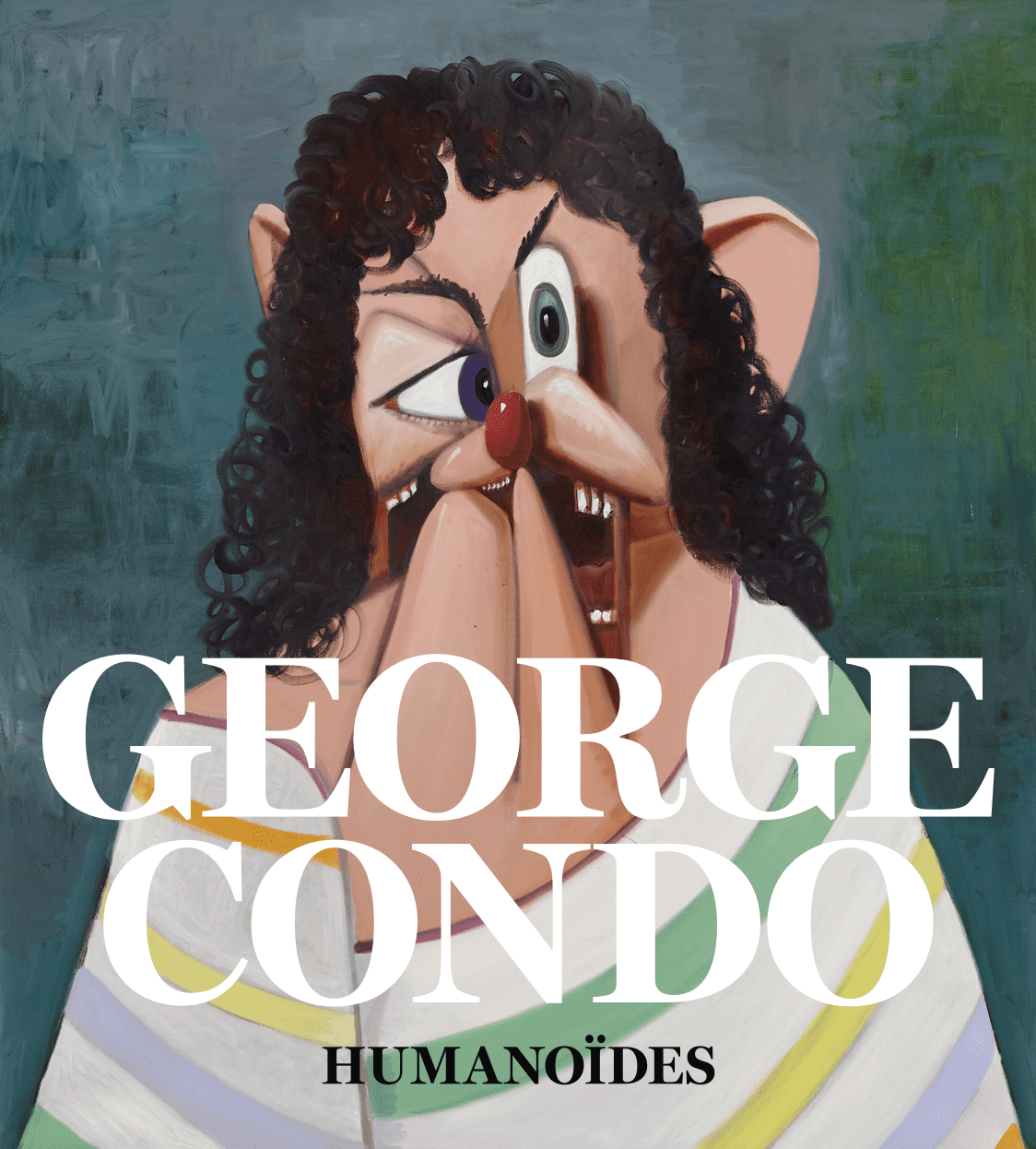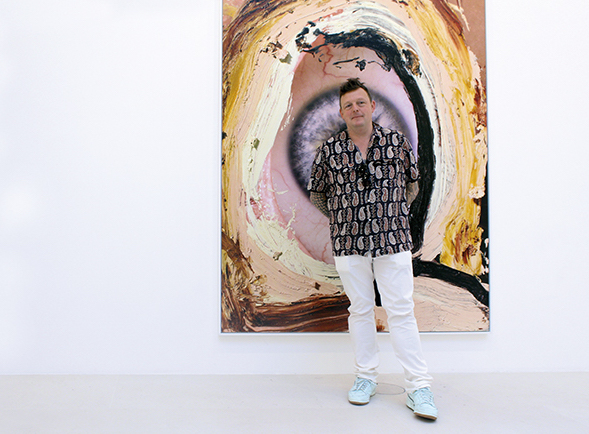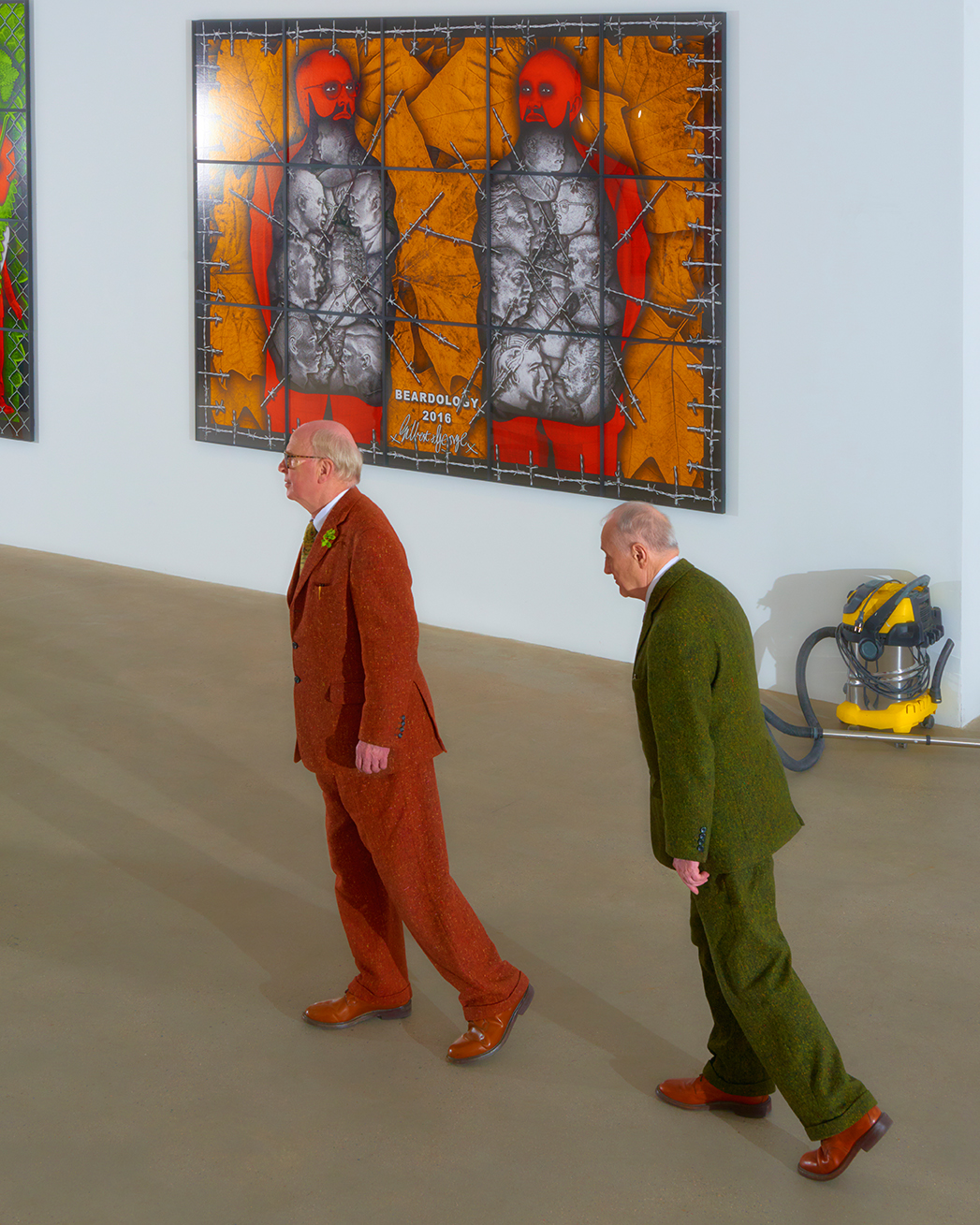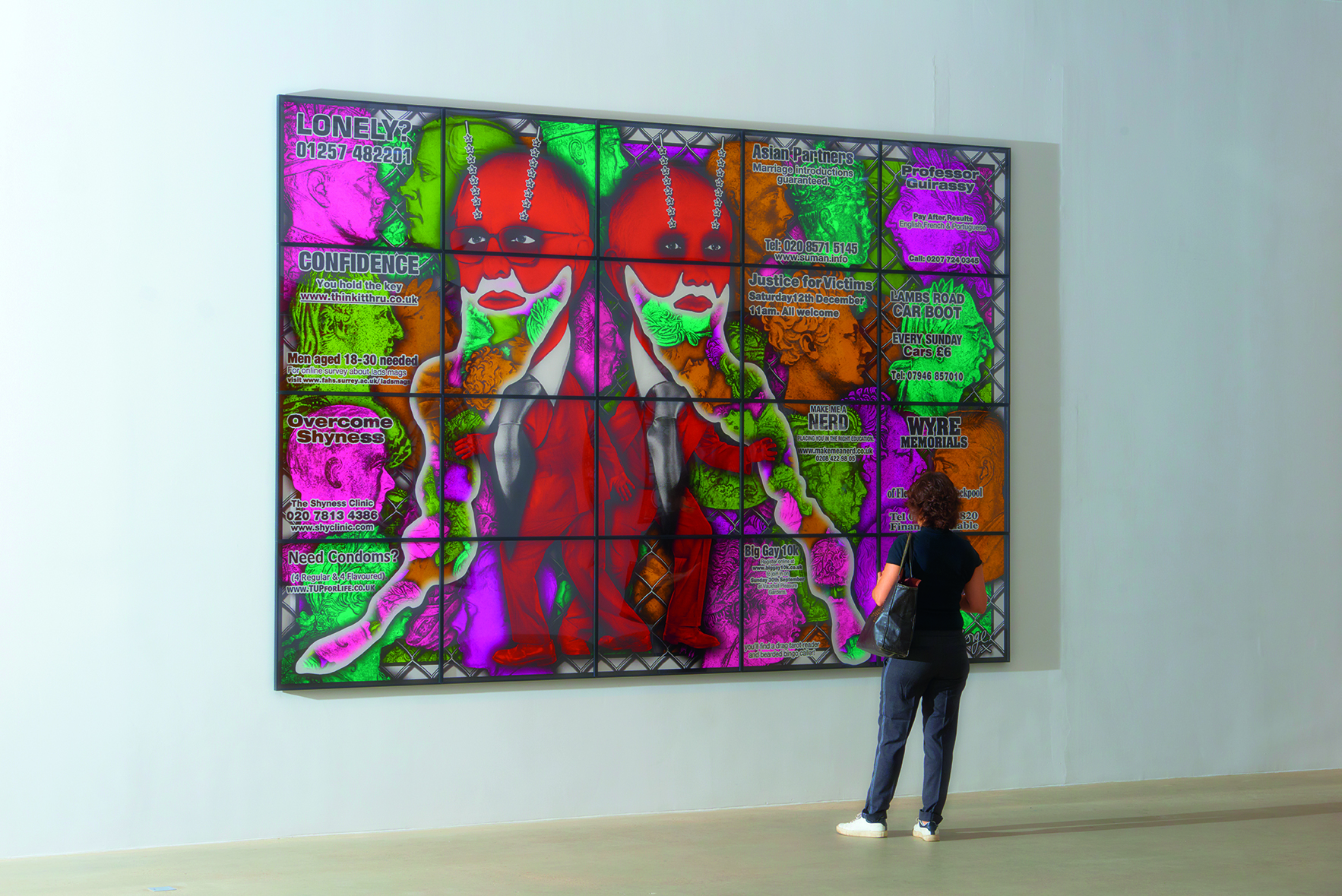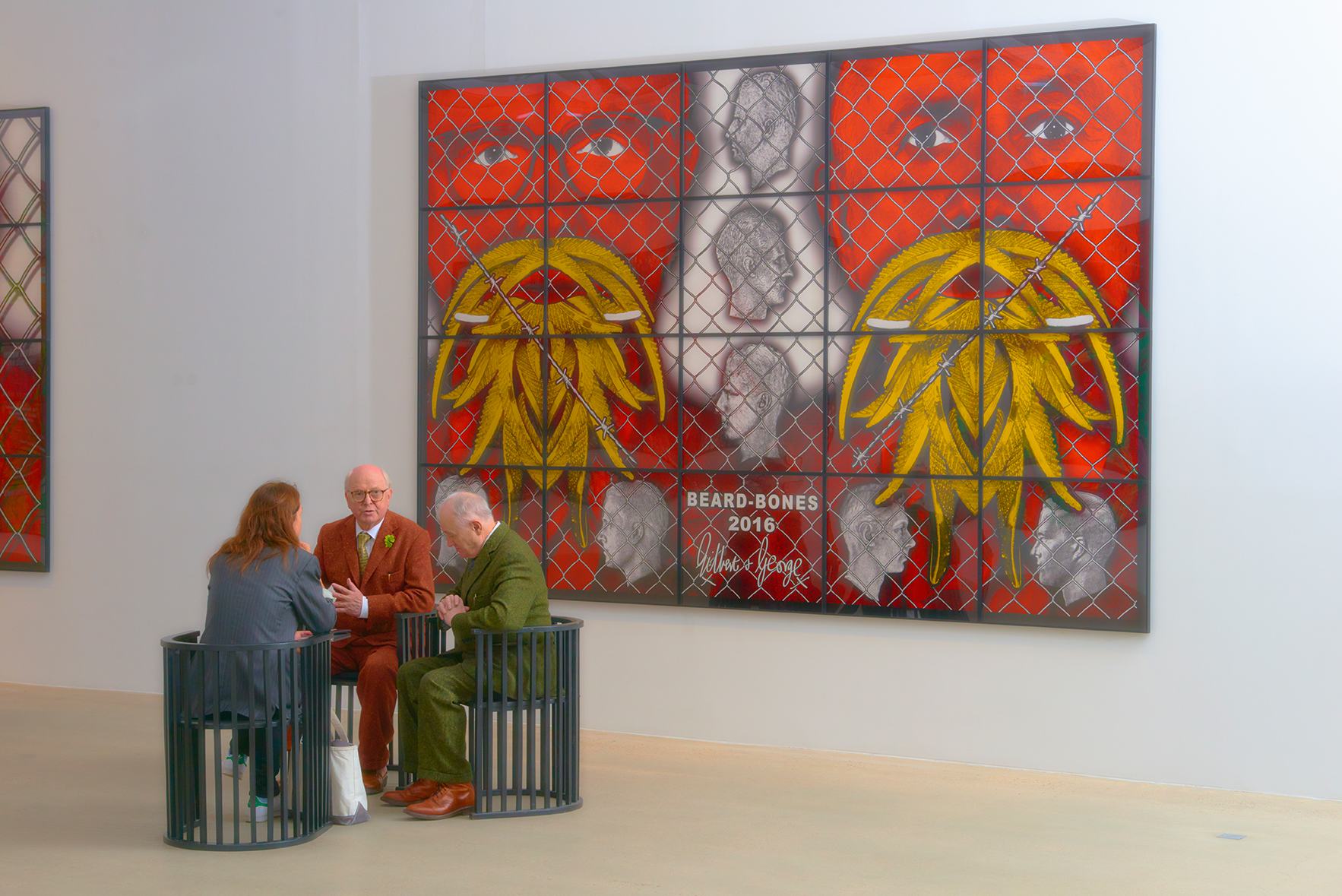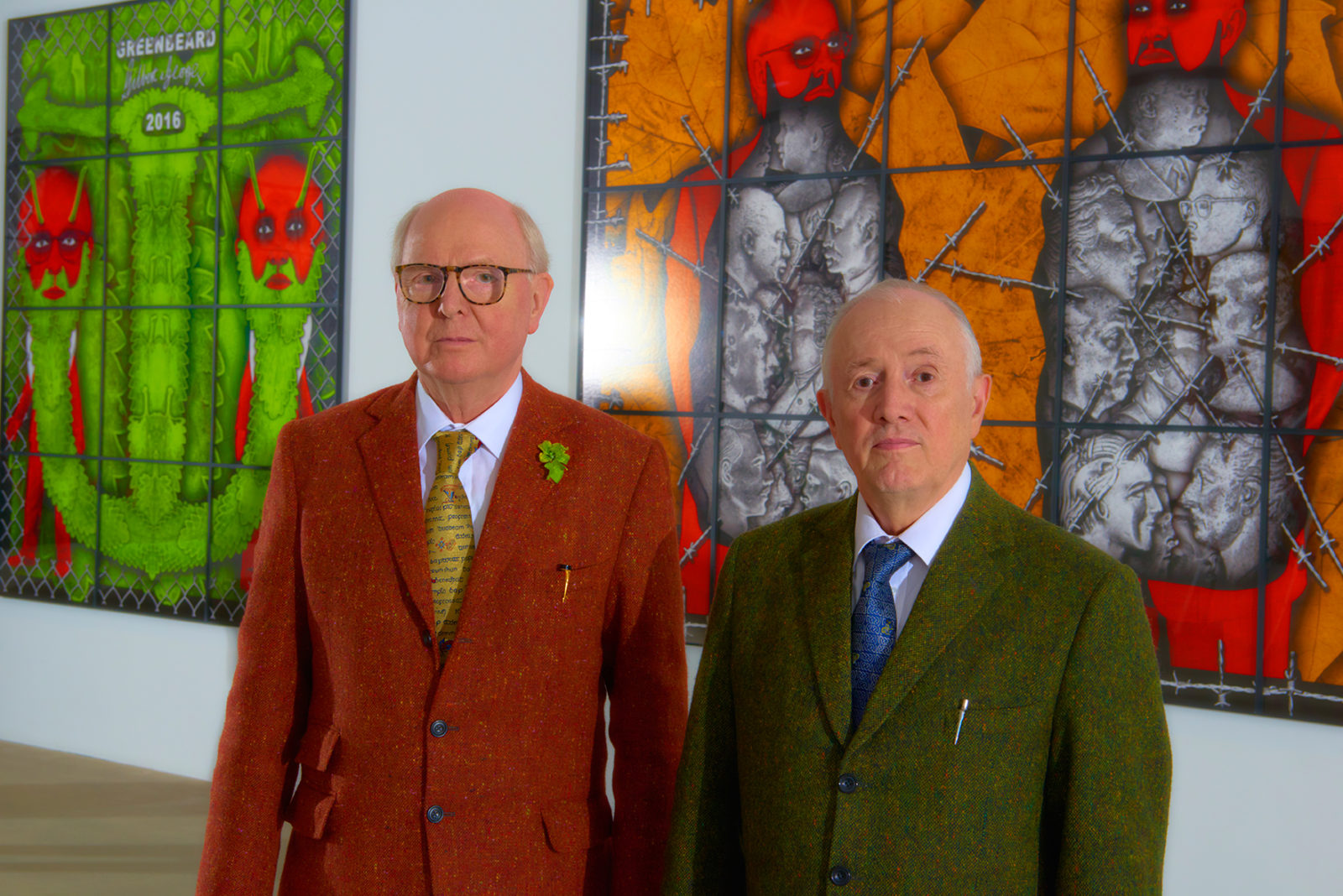
Photo by Boris Camaca
A MEETING WITH GILBERT & GEORGE
By Armelle Leturcq
Through the power of images and strong visual messages, Gilbert & George have greatly impacted the art world since the 1960s. Over the years, the iconic duo has invented new ways of creating and showcasing art, becoming their own live sculptures and constantly striving for complete freedom as artists and human beings. Unapologetic, rebellious, and wildly curious, Gilbert & George are celebrating fifty years of work with an exhibition collecting their “Beard” pictures and touring worldwide from New York to Paris. We sat down to chat with the duo at Galerie Thaddeus Ropac, where the exhibition takes place until January 20th.
This exhibition is important for you since it’s the 50th anniversary of your work together?
George: Yes, 50 years of making art.
Gilbert: It’s the celebration of the Beard Pictures, also, which is another long journey. It’s been two and half years.
George: They are divided into 6 shows, in New York, Paris, Brussels, London, Naples, and Athens. All the exhibitions will have different pictures. There are 172 in total.
Gilbert: Here, there are roughly 40 pictures, thirty-five in America and nearly 50 in London.
It’s a huge project!
Yes, it’s a very big project and without assistance. (laughs)
How do you produce this kind of imagery?
Gilbert: It’s quite simple. First, we take half a year of taking images and then put them together into books of contact sheets. Then we lay them down in the studio on tables and choose the best. Then we make a design on top of them.
Do you also use computers?
George: We use a computer like Van Gogh used a brush. He did his pictures with his head, his soul, and his sex. We do that as well.
Gilbert: It’s like making a composition as the Renaissance painters did. They had the mountains, they had Jesus and the Devil… all super important to create a composition.
George: Except they were doing it to terrorize people! We only try to inform.
Gilbert: Our art is free from religion, morality, or God. We never had an apology from the Church, not once. The pope never apologized for what they did for 2,000 years!
George: They could just say, “Sorry, we’re very good people but we did some very bad things.” We went to Lisbon once, many years ago and they proudly showed us a building where the details of the Inquisition are kept. It was really terrific!
You don’t like religion?
George: We’d like to ban religion and decriminalize sex.
Gilbert: We had a big slogan that read “Ban religion” because I realized that, even where we are, there are so many humans, whether it be in South America or Bangladesh, that segregate themselves because of religion.
In what education were you brought up?
George: Whether we like it or not, all of us are greco-romano-judeo-christian secularists. That was the great invention of the western world and a fantastic privilege!
Gilbert: Art education liberated me from religion. Now I don’t feel the need to be part of any religious matter.
You also met each other in art school?
Gilbert: Yes, we met at Saint Martin’s School of Art in London. It was a brilliant art school in my opinion. It was the first time I felt free to do whatever I wanted.
George: It was a strange simplicity because the man who invented the course that we were on, “Advanced Sculpture,” did it because he used to be in the army in the desert. He thought the war was such a nightmare that he decided to create this course. He was very sweet. His class was very different from all the rest of the college. In a way, it was the elitist department. We felt quite superior.
At the beginning, you wanted to be sculptors?
George: We were trained as sculptors.
Gilbert: When we finished the school, the realization came that we were alone in the world. We weren’t part of the school anymore. That began our vision that we could be the artwork ourselves. We didn’t have a studio, we weren’t able to earn money.
You didn’t want to create objects?
George: No, we only created objects as students, it was like practicing. Because we didn’t come from a middle-class background, we didn’t have a safety net. It made us much more determined.
Gilbert: At the end of our school, we were making art that we could hold, like a ball, a stick, a square. Halfway through, taking images of us, we realized we didn’t need any other medium. Then we created a system to leave ideas behind. We developed this new idea of how to make modern art with modern pictures without a canvas or brushes.
George: We felt we had something new to say and we didn’t want to buy a canvas like any other artist. We wanted a new form. It took us a long time to figure out what would be that new form. We knew we could do it with a camera because it’s something real and tangible.
Gilbert: Freezing the image, that’s the key.
George: All the figures in the museum could be fake. With a camera, you know it’s real. Because our camera was black & white, we didn’t use color. At that time, color film was something related to lower-class holidays and parties. It wasn’t regarded as a serious form. Then we found a way to add red. In a way, we were really slow learners. Every child has a box of colors, but we started without any.
Gilbert: Also, we didn’t know how to make a big artwork. We made very small photographs in the beginning. We used to create compositions with scattered pieces. We turned twenty little images into one big artwork. We managed very slowly to push them together into a rectangle.
In a certain way, you became photographers in spite of yourselves?
Gilbert: We never wanted that. It’s the image that’s important.
George: We developed everything by ourselves and we were never trained in photography. That meant we had to do it in a very homemade way.
Gilbert: We press that button. We used cardboards, it was quite laborious. We only used computers in the last eighteen years. It’s the same language but in a modern way.
George: People are always surprised that we use computers, but no one asked Van Gogh if he used brushes.
Gilbert: It’s very important for us to use our language. We invented it for ourselves.
All these colors are very strong.
Gilbert: Like a writer, we are able to speak. I almost feel like I’m writing a novel, page by page. It’s like seeing the whole world through beards.
When did you begin large-scale photography?
Gilbert: In 1974. The first one was 2.5 meters by 2 meters. In 1982, we did 11 meters. Then we did a very big one in 1985 that now belongs to the Louis Vuitton Foundation. We also did very big drawings at the beginning.
How do you consider your work in the field of performance? Your artwork “Singing Sculptures” was considered as a performance?
George: We never did performance, we always did living sculptures. Generally speaking, performance alienates uneducated people.
You are completely indifferent to all the 70s performers?
Gilbert: We never wanted to go in that direction because we are the art. It’s a continuous artwork.
What is your relationship to clothing? Was it your decision to have a very British look?
George: We always said we didn’t want to be the artist our mothers would be ashamed of!
Gilbert: Our clothes were very useful for us because it set us apart from other people. They didn’t know what it was, but they knew it was something different. Last week, we walked the streets of New York and people were coming up to us, complimenting us on our suits while they didn’t know who we were.
In 1969, when you began, no artists were dressed like you!
George: A suit is considered very normal. It’s easy to get a table at any restaurant with a suit. It’s only in the art world that it’s considered weird. We always say, we don’t want to be normal because everybody is. We don’t want to be weird because most artists see themselves as weird. We try to be a bit normal and bit weird.
Gilbert: Freedom of speech, that’s what art is.
Did you also want to create characters?
Gilbert: It comes to us naturally, we don’t have to think about clothes. You don’t have to think about shirt or shoes.
George: If you look at artists from the early 70s, they all look so weird. With our suits, we don’t relate to a particular decade. When we see men in their 40s or 50s still trying to keep a young style, it’s quite embarrassing.
Where do your suits come from?
George: All our tailors died.
Gilbert: They were all Jewish tailors in our street in East London. Now we go to Nicolas of London, he’s a Greek tailor.
George: He was trained at Saville Row but would never impose anything or tell us what we want.
Gilbert: We already know exactly what we want.
Do you consider your life a piece of art?
George: Yes, of course. Or rather it allows for the art.
Gilbert: It’s amazing that we can always express ourselves after 50 years. I feel like nothing has changed. Our pictures have to stimulate the viewer, they have to be aggressive, a bit in your face. They have to be memorable, whether it be the beard, the barbwire, the funny nose, or the text…
Is the main topic of your work liberty?
Gilbert: Yes, the viewer has to be like us, on the same level. We’re all the same human beings. We deal with pro and anti-religion, politics…
George: We think culture is more advanced than politics. Politicians only change policies when they are obliged to. It never springs from an idea. Novelists play a big part in politics also. Child labor laws only changed three years after Dickens’ books. It’s quite scandalizing. The power of culture is extraordinary. It’s very quiet, unspoken. Some artists and writers manage to speak from the grave through their timeless work.
What are the topics of this show?
Gilbert: It is mostly about barbwire, fencing, burglar alarms, and we also masked ourselves with leaves which become beards or points of history. Even if you’re very famous, some pieces of art disappear totally and some remain.
George: If you’re very wicked you remain, generally.
Gilbert: We were able to turn the beards into gates.
George: Where can the beard take us? When we were teenagers, we couldn’t get a job in London with a beard. They would think you were a hippy or dirty.
Gilbert: We realized the history of beards. Jews, Sikhs…even hipster beards! In London they have moustache parties for girls.
George: Girls all want a young man with a beard and shorts.
Gilbert: If you close your eyes, you can see the world totally differently. You can see small figures with big heads, an old man walking in a jungle as if it was the ruins of history.
What does it mean for you to work together for 50 years?
George: Extraordinary joy! Everybody told us it wouldn’t last, but it did. We’re explorers as well, that’s why.
Gilbert: It’s very simple. We come from poor families so we had to win. We’re always hungry for more. After our six shows this year, we are doing another round of six museum shows next year.
What do you think of the situation today: digital images, Internet… Do you protect yourself from all this?
Gilbert: We don’t have a mobile phone. Maybe one day we’ll be forced to. We have an assistant who helps us with emails and such. We are still very attached to objects. We don’t want just a digital image, something from outer space. We are also into the old-fashioned tangible invitations that we completely produce ourselves like our books and catalogue. We do all graphic design because it’s part of our artwork.
George: Finding a lunch menu from 1931 would be fascinating!
All photos by Boris Camaca.






